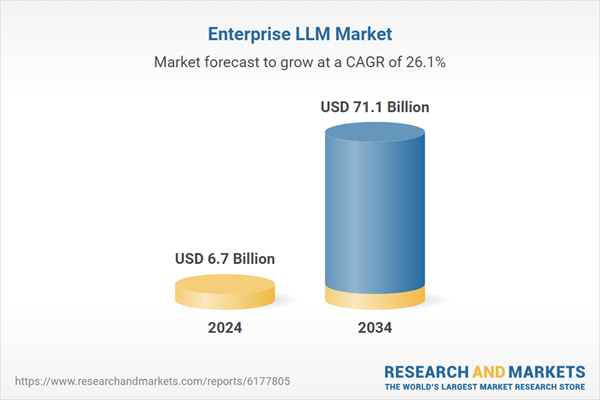The rise of enterprise-grade LLM adoption is primarily driven by a mix of strategic public initiatives and increasing private sector investment. Government efforts are accelerating adoption by promoting safe, transparent, and unbiased deployment of AI systems through updated regulatory frameworks and oversight mechanisms. This regulatory clarity encourages fair procurement processes for LLM vendors while enhancing trust in enterprise AI. Private sector growth is fueled by a push for efficiency, cost savings, and innovation, particularly in data-intensive workflows. Enterprises are actively deploying LLMs to streamline service delivery, increase automation, and manage unstructured data at scale. Industry-specific LLMs are also gaining traction, with organizations across sectors such as defense, healthcare, and scientific research integrating domain-trained models to handle highly specialized workloads. These enterprise deployments are reshaping internal operations, knowledge management, and decision-making processes with improved responsiveness and accuracy.
In 2024, the general-purpose LLMs segment held a 54% share. Businesses are choosing general-purpose models for their adaptability, scalability, and minimal customization requirements. These models can be deployed across multiple departments and support a broad array of use cases such as virtual assistance, knowledge retrieval, and document processing. Major enterprise-focused providers like Microsoft, Google, and OpenAI are enhancing accessibility by offering robust, cloud-based LLM integrations that reduce friction for implementation across existing infrastructure.
The software segment is anticipated to grow at a CAGR of 28.2% between 2025 and 2034. Software offerings, including model APIs, training platforms, inference tools, and analytics dashboards, are enabling rapid deployment and seamless model interaction. Enterprises prefer software-driven LLM solutions due to their ability to deliver fast model updates, lower maintenance requirements, and flexible deployment options. Providers such as Cohere, Anthropic, and Stability AI continue to expand their software ecosystems for enterprise-level workflows, further boosting adoption across sectors.
United States Enterprise LLM Market generated USD 3 billion in 2024. The US landscape benefits from a strong policy framework focused on AI infrastructure, risk mitigation, and innovation acceleration. Federal-level plans encourage early adoption and scale-out of enterprise AI initiatives, promoting cloud build-outs, responsible model usage, and secure deployment practices. National institutions are laying out guidance on adversarial machine learning risks and shaping best practices for managing and mitigating bias, ensuring enterprise LLMs are deployed ethically and transparently across agencies and industries.
Key players in the Enterprise LLM Market include Meta, AWS, Mistral AI, OpenAI, AI21 Labs, Microsoft, Stability AI, Cohere, Google, and Anthropic. To secure their foothold in the enterprise LLM market, major players are heavily investing in model fine-tuning, vertical-specific solutions, and scalable cloud-native infrastructures. Companies like OpenAI, Microsoft, and Google are focusing on seamless enterprise integration by building secure APIs, offering compliance-ready deployment options, and partnering with large organizations for tailored implementations. Players such as Cohere and AI21 Labs are differentiating through retrieval-augmented generation (RAG) frameworks and low-latency inference engines.
Comprehensive Market Analysis and Forecast
- Industry trends, key growth drivers, challenges, future opportunities, and regulatory landscape
- Competitive landscape with Porter’s Five Forces and PESTEL analysis
- Market size, segmentation, and regional forecasts
- In-depth company profiles, business strategies, financial insights, and SWOT analysis
This product will be delivered within 2-4 business days.
Table of Contents
Companies Mentioned
The companies profiled in this Enterprise LLM market report include:- OpenAI
- Anthropic
- Microsoft
- Meta
- AWS
- IBM
- Oracle
- NVIDIA
- Salesforce
- Cohere
- Regional Champions
- Baidu
- Alibaba Cloud
- DeepMind
- Mistral AI
- XAI
- Hugging Face
- Cerebras Systems
- Stability AI
- AI21 Labs
- Inflection AI
- Jasper AI
- Runway
- Adept
- Peltarion
Table Information
| Report Attribute | Details |
|---|---|
| No. of Pages | 220 |
| Published | September 2025 |
| Forecast Period | 2024 - 2034 |
| Estimated Market Value ( USD | $ 6.7 Billion |
| Forecasted Market Value ( USD | $ 71.1 Billion |
| Compound Annual Growth Rate | 26.1% |
| Regions Covered | Global |
| No. of Companies Mentioned | 27 |









